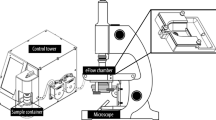Abstract
Purpose
To suggest a method for evaluating the accuracy of different kinds of sperm counting chambers by eliminating errors concerned with human skills or semen properties. In this method, various concentrations were prepared from stocks of commercially available latex beads (Accu-beads, Hamilton-Thorn Research, Beverly, MA). Samples from identical preparations were loaded into different types of chambers, namely, hemocytometer (Neubauer, improved double, Superior Ltd, Germany), Makler (Sefi Medical Instruments, Haifa, Israel) and Horwell (Horwell Ltd, London, UK). Beads were counted by both direct microscopic observation and by strict scanning of their photographed images.
Results
In all cases, counts by direct observation were about 5% higher than strict counts of the same photographed beads. Counting photographed beads showed high reproducibility (average CV of 5.1%) between samples in the two wells of the hemocytometer. Counts of photographed beads, sampled from identical stocks, were on average slightly lower in the Makler chamber (20.7 × 106/ml) and much higher in the Horwell chamber (47.4 106/ml) than counts in the hemocytometer (21.5 × 106/ml). Samples from three different batches of Accubeads revealed slight variation in counts between the batches and an average concentration of 11% above the number indicated on the commercial product.
Conclusions
A technique that combined loading latex beads from identical stock into various chambers, proper covering of the tested samples and strict counting of photographed beads provided precise and reproducible results. By eliminating most errors related to human skills and semen properties, this method is suitable for evaluating the accuracy of counting chambers.
Similar content being viewed by others
References
World Health Organization: WHO Laboratory Manual for the Examination of Human Semen and Sperm-Cervical Mucus Interaction, 3rd ed. Cambridge, UK, Cambridge University Press, 1992, pp 1–107
Jequier AM, Crich JP: Semen Analysis, A Practical Guide. Blackwell, Oxford, 1986, pp 43–55
Makler A: The improved 10 mic chamber for rapid sperm count and motility evaluation. Fertil Steril 1980;33:337–338
Mortimer D: The male factor in infertility. Part 1: Semen analysis.In Current Problems in Obstetrics, Gynecology and Infertility. Vol VIII, No 7. Year Book Medical Publishers, Chicago. pp 21–30
Freund M, Carol B: Factors affecting haemocytometer counts of sperm of sperm concentration in human semen. J Reprod Fertil 1964;8:149–155
Jequier AM, Ukombe EB: Errors inherent in performance of routine semen analysis. Br J Urol 1983;55:434–436
Knuth UA, Niechlag E: Comparison of computerized semen analysis with the conventional procedure in 322 patients. Fertil Steril 1988;49:881–885
Mortimer D, Shu MA, Tan R: Standardization and quality control of sperm concentration and sperm motility counts in semen analysis. Hum Reprod 1986;1:299–303
Menkvasld R, Van Zyl JA, Stander FS, Conradie E, Kopper K: A comparative study of the white cell pipette method and the Makler counting chamber method of counting spermatozoa. S Af Med J 1988;145:229–233
Tomoyoshi T, Ishida A, Kim CJ: Use of the Makler counting chamber in sperm analysis. Hynkokyka-Kiyo 1988;34:1931–1933
Dumphy BC, Kay R, Barrat CLR, Cooke ID: Quality control during the conventional analysis of semen. An essential exercise. Andrologia 1989;10:387–385
Zaneveld LJD, Jeyendran RS: Modern assessment of semen for diagnostic purposes. Semin Reprod Endocrin 1988;6:323–337
Yanagida K, Hoshi K, Sato A, Burkman L: Automated semen analysis shows an increase in sperm concentration and motility with time in Makler chambers having excess sample volume. Hum Reprod 1990;5:193–196
Peters AJ, Zaneveld LJ, Jeyendran RS: Quality assurance for sperm concentration using latex beads. Fertil Steril 1993;60:702–705
Cooper TG, Newinger J, Bahrs S, Nieschlag E: Internal quality control of semen analysis. Fertil Steril 1992;58:172–178
Makler A: Quality control of sperm counting (letter). Fertil Steril 1994;62:202–203
Imade GE, Towobila OA, Sagay AS, Otubu JAM: Discrepancies in sperm count using improved Neubauer, Makler, and Horwell counting chambers. Archiv Androl 1993;31:17–22
Ginsburg KA, Armant DR: The influence of chamber characteristics on the reliability of sperm concentration and movement measurements obtained by manual and videomicrographic analysis. Fertil Steril 1990;53:882–887
Author information
Authors and Affiliations
Rights and permissions
About this article
Cite this article
Shiran, E., Stoller, J., Blumenfeld, Z. et al. Evaluating the accuracy of different sperm counting chambers by performing strict counts of photographed beads. J Assist Reprod Genet 12, 434–442 (1995). https://doi.org/10.1007/BF02211144
Received:
Accepted:
Issue Date:
DOI: https://doi.org/10.1007/BF02211144




